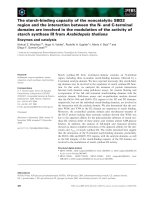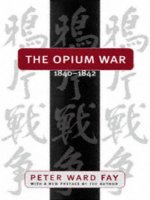THE DO’S AND DON’TS OF WRITING AN ABSTRACT 10 ĐIỂM
Bạn đang xem bản rút gọn của tài liệu. Xem và tải ngay bản đầy đủ của tài liệu tại đây (92.31 KB, 14 trang )
<span class="text_page_counter">Trang 1</span><div class="page_container" data-page="1">
The <i>Do’s</i> and <i>Don’ts </i>
of Writing an AbstractMcNair Scholars Program
University of California, Santa BarbaraSummer 2011
</div><span class="text_page_counter">Trang 2</span><div class="page_container" data-page="2">An abstract is a self-contained, short, and powerful statement that describes a larger work. It is a mini-version of your paper.
Condensed version of a longer piece of writingHighlights the major points covered
Concisely describing the content and scope of the work.
<b>General information:</b>
100-350 words
Accompanies papers, articles, reports, etc.
Used for presentation at conferences, symposia
What is an abstract?
</div><span class="text_page_counter">Trang 3</span><div class="page_container" data-page="3">Purpose of an Abstract
Allows a reader to quickly and accurately identify the basic content of your paper. Readers should be able to read your abstract to see if the related research is of interest to them.
Helps reader decide whether to read the entire article or paperProvides reader with a preview of research
Helps conference committee to group it with similar papers for a panel
When can you write an abstract?
You can begin to write prior to having a paper. It serves as a proposal for panels or articles.
You can write the abstract after you’ve written your paper.
</div><span class="text_page_counter">Trang 4</span><div class="page_container" data-page="4">What should an abstract tell the reader?
WHATyou didWHYyou did itHOWyou did itWHATyou foundWHATit means
</div><span class="text_page_counter">Trang 5</span><div class="page_container" data-page="5">subaltern function, I will examine two incidents: the 1984 McDonalds shooting in San Ysidro, California, and the 1997 death of Ezequiel Hernández in Redford, Texas. These cases are indicative of the politically charged environment of a border region that in becoming an increasingly militarized zone has also set the stage for a cultural battle amongst different forms of knowledge construction and legitimation.
</div><span class="text_page_counter">Trang 6</span><div class="page_container" data-page="6"><b>Biological Sciences:</b>
"The Listeria monocytogenes p60 Protein is not Essential for Viability in vitro, but Promotes Virulence in vivo"
Author: Sina Mohammedi
Intracellular pathogens (agents which infect host cells), such as Mycobacterium tuberculosis and Listeria monocytogenes, cause very high mortality rates in the United States. Therefore, deciphering the mechanisms through which the
pathogens cause disease is of great interest.[…] My work involves one such
secreted protein, called p60. P60 is an antigen (an agent seen by the host immune system) implicated in regulated bacterial cell wall breakdown. The objective of this study was to examine two questions: first, is p60 essential to the viability of
Listeria, as previously published? and second, is p60 a virulence factor in Listeria? […] p60 is indeed a key factor in the disease-causing ability of Listeria, but not essential for viability. Future studies will focus on the precise role of p60 in Listeriapathogenesis. This work increases our understanding of such diseases as
tuberculoses, various food poisonings, and meningitis. Sciences Abstract
</div><span class="text_page_counter">Trang 7</span><div class="page_container" data-page="7">What abstract requests look like: Humanities
<b><small>Filming the Internet --SCMS Panel, Conference March 10-13] </small></b>
“Please submit an abstract with 5 item bibliography and CV or author's bio to
Submit abstracts by Tuesday, August 8th. All submissions will receive a response on or before Sunday, August 15th.”
Abstract for a conference panel (Humanities):
“Please send a 250-word abstract and a brief bio to Sarah Gleeson-White Melissa Hardie 1 October 2011. Final submissions will be due 1 February 2012. All articles are refereed and should not normally exceed 6, 000 words in length. Enquiries welcome.”
<b><small>sarah.gleeson-CFP: The Materials of American Studies</small></b>
Abstract for a Journal article consideration (Humanities):
“An abstract (~300 words) may be sent to on or before May 15, 2011. Full paper, neatly typed in Times New Roman with 1.5 line spacing, will be of around 3000-4000 words, and must be submitted on or before July 30, 2011. MLA 2007 style sheet preferred. A hard copy of the same should be mailed to Dr. Jaydip
<b><small>CFP: The Materials of American Studies</small></b>
Abstract accompanying an article (Humanities):
</div><span class="text_page_counter">Trang 8</span><div class="page_container" data-page="8">Abstract accompanying an article (Science):
“The Abstract should be informative and completely self-explanatory, briefly present the topic, state the scope of the experiments, indicate significant data, and point out major findings and conclusions. The Abstract should be 100 to 200 words in length.. Complete sentences, active verbs, and the third person should be used, and the abstract should be written in the past tense. Standard nomenclature should be used and abbreviations should be avoided. No literature should be cited.”
<b><small>Journal of Environmental Chemistry and Ecotoxicology</small></b>
Abstract for paper at a conference + Journal (Science):
“Authors are invited to submit abstracts (maximum 200 words) for presentation at the 2011 SEAg Conference and for inclusion in the Conference proceedings. Each abstract will be reviewed by the scientific committee before inviting the authors to submit the full article. Conference participants will be invited to submit an updated version of the conference papers as a Journal article to be published in the "Australian Journal of Multi-disciplinary Engineering"
<b><small>The Society for Engineering in Agriculture 2011</small></b>
</div><span class="text_page_counter">Trang 9</span><div class="page_container" data-page="9">Abstract for Conference (Social Science):
All abstracts will be thoroughly peer reviewed and must be in keeping with the conference themes;
Abstracts must be no more than 300 words in length;
At least one journal special issue and a book are planned outputs from the meeting, please indicate your willingness to be considered for these on your abstract;
<b><small>The York Deviancy Conference</small></b>
Abstract with an article for a Journal (Social Science):
Abstracts should contain a maximum of 250 words and should not contain figures
All accepted abstracts submitted before the deadline will be published in the Abstract and Programme book
It is your responsibility to ensure that your abstract is correct. Corrections to abstracts will not always be possible once the abstract deadline has passed.
Abstract submissions will only be accepted via the meeting website
<b><small>Journal of World Mathematical Review</small></b>
</div><span class="text_page_counter">Trang 10</span><div class="page_container" data-page="10">Parts of the Abstract
Purpose
<small>: </small><small>Why do we care about the problem? Explain the purpose of your study/paper. Why did you do the research? Ideally in one sentence, state the primary objectives and scope of the study or the reasons why the document was written. </small>
Methods/procedure/approach
<small>: </small><small>What did you actually do to get your results? (e.g. analyzed 3 novels, completed a series of 5 oil paintings, interviewed 17 students). Clearly state the techniques or approaches used in your study. For papers concerned with non-experimental work (such as those in the humanities, some social sciences, and the fine arts) describe your sources and your use/interpretation of the sources. </small>
<small>Describe your results (the findings of your experimentation), the data collected, and effects observed as </small>
<small>informatively and concisely as possible. These results may be experimental or theoretical, just remember to make note of that in your abstract. Give special priority in your abstract to new and verified findings that contradict previous theories. Mention any limits to the accuracy or reliability of your findings. </small>
Conclusion/implications
<small>: </small><small>What are the larger implications of your findings, especially for the problem/gap identified in step 1? : Why are the results of your study important to your field and how do they relate to the purpose of your investigation? Often conclusions are associated with recommendations, suggestions and both rejected and accepted hypotheses. </small>
</div><span class="text_page_counter">Trang 11</span><div class="page_container" data-page="11">Strategies for putting one together
Cut and Paste Approach:
<small>Read your completed draft (if you have one) and highlight the key points of your argument.Cut and past those highlighted portions into a new document</small>
<small>Synthesize, adding and removing according to the call of abstract criteria. </small>
Research Summary Approach:
<small>Write a complete, concise account of the work and findings.Determine, according to the criteria significant info is missing</small>
<small>Edit the abstract down through revisions to the specifications of the call. </small>
Component Outline Approach:
<small>Write the abstract in parts (eg., purpose, method, findings, etc.)</small>
<small>Edit with attention to bringing the parts together into one cohesive account of the workAdd evidence, words to make the abstract flow and read smoothly.</small>
</div><span class="text_page_counter">Trang 12</span><div class="page_container" data-page="12">Some Caveats on Writing Abstracts
Formal diction: no casual or colloquial phrasing Avoid jargon if possible
Do not use contractions (couldn’t, didn’t, etc.)
Use abbreviations to avoid repetition, but only after you have defined themDo not include personal narrative, opinion or commentary
Try to write in the third person singularUse active voice rather than passive voiceUse complete sentences
</div><span class="text_page_counter">Trang 13</span><div class="page_container" data-page="13">








